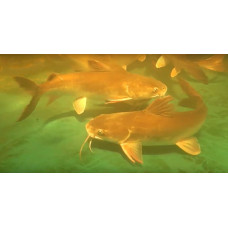Latin name
Neoarius leptaspis
Other name
Boofhead catfish, freshwater forked tailed catfish, lesser salmon catfish, triangular shield catfish.
Identification
It was described by Pieter Bleeker in 1862, originally within the genus Hexanematichthys.
Features of fish fins
Dorsal spines (total): 1; Dorsal soft rays (total): 7; Anal spines: 0; Anal soft rays: 16-20.
Fish colouring
The body of this fish is silvery gray.
Distribution
Occupy the western Pacific: northern Australia and central-southern New Guinea.
Habitat
A marine, tropical, bottom-dwelling species. They live in marine, brackish and freshwater waters, with a maximum known depth of 135 m (443 ft).
Size
Maximum length 60 cm.
Behavior
Like to swim in freshwater in headwater streams, also found in brackish estuaries and lower reaches of rivers.
Food and feeding habits
Their diet includes insects, clams, shrimp, swimmers and aquatic plants.
Reproduction
Breeds during the late dry and early wet seasons (September to January) in coastal lagoons and submerged marshes. Males incubate eggs orally until fry hatch and then guard them for 4 weeks.
Fishing
Salmon catfish are harvested commercially and for aquarium culture.
Relationship with a person
They are an important food fish.
Traumatogenic for humans.
| Classification | |
| Phylum | Chordata |
| Class | Actinopterygii |
| Squad | Siluriformes |
| Family | Ariidae |
| Genus | Neoarius |
| Species | N. leptaspis |
| Features | |
| Conservation status | Not Evaluated |
| Habitat | Bottom |
| Life span, years | No information |
| Maximum body weight, kg | No information |
| Maximum length, cm | 60 |
| Sailing speed, m/s | No information |
| Threat to people | Edible |
| Way of eating | Predator |
Salmon catfish
Tags: salmon catfish


